![]()
![]()
![]()
Use LEFT and RIGHT arrow keys to navigate between flashcards;
Use UP and DOWN arrow keys to flip the card;
H to show hint;
A reads text to speech;
50 Cards in this Set
- Front
- Back
|
What are the four stages of external respiration? |
1. Exchange of air between atmosphere and lungs 2. Exchange of oxygen and carbon dioxide between lungs and blood 3. Transport of oxygen and carbon dioxide by blood 4. Exchange of gases between blood and cells |
|
|
What is the difference between pulmonary circulation and systemic circulation? |
Pulmonary = gas exchange between blood and lungs Systemic = gas exchange between blood and system cells. |
|
|
What are the primary functions of the respiratory system? |
1. Exchange of gases between the atmosphere and the blood 2. Homeostatic regulation of body pH 3. Protection from inhaled pathogens and irritating substances 4. Vocalisation |
|
|
What are the three main constituents of breathing anatomy? |
1. Conducting system - airways 2. Exchange surface - alveoli 3. Chest cavity - bones and muscles |
|
|
Name the components of the anatomy of the respiratory system |
1. Nasal cavity 2. Tongue 3. Larynx 4. Vocal Cords 5. Pharynx 6. Esophagus 7. Trachea 8. Left Lung & Left Bronchus 9. Right Lung & Right Bronchus 10. Diaphragm |
|
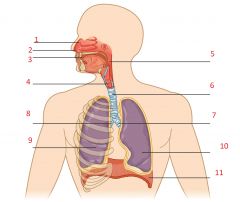
Label this diagram of the respiratory system: |
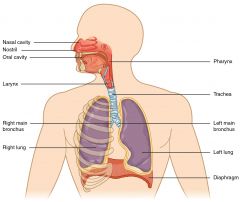
1 - Nasal cavity 2 - nostril 3 - oral cavity 4 - larynx 5 - pharynx 6 - trachea 7 - left main bronchus 8 - right main bronchus 9 - right lung 10 - left lung 11 - diaphragm |
|
|
How many lobes do the right and left lungs have? Name them. |

|
|
|
What is the cardiac notch? |
Area in the left lung where the heart sits. |
|
|
What muscles are required for expiration? |
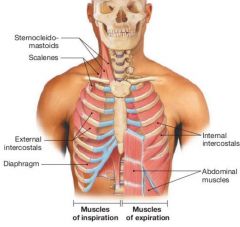
1. Internal Intercostals 2. Abdominal muscles |
|
|
What muscles are required for inspiration? |
1. Sternocleidomastoids 2. Scalenes 3. External intercostals 4. Diaphragm |
|
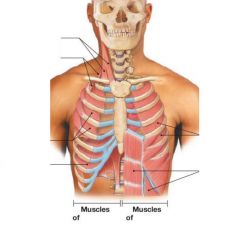
Label: |
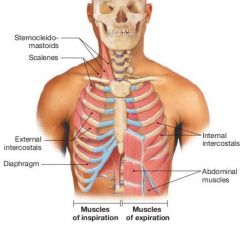
|
|
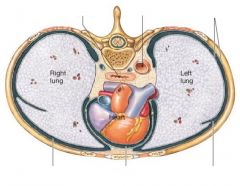
Label: |
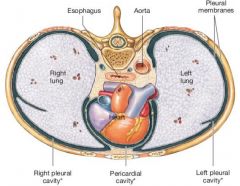
|
|
|
How many times does the primary bronchus divide before terminating in a cluster of alveoli? |
22 times. |
|
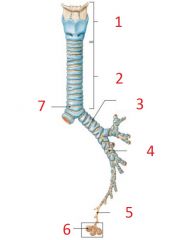
Label: |
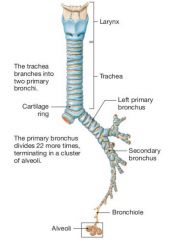
1 - larynx 2 - trachea 3- left primary bronchus 4 - secondary bronchus 5 - bronchiole 6 - alveoli 7 - cartilage ring |
|
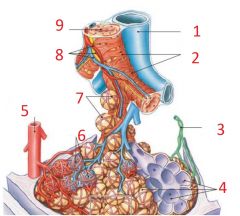
Label: |
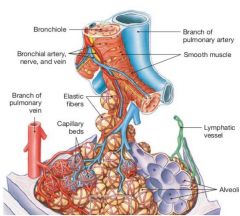
1: Branch of pulmonary atery 2. smooth muscle 3. lymphatic vessel 4. alveoli 5. branch of pulmonary vein 6. capillary bed 7. elastic fibres 8. bronchial artery, nerve and vein 9. bronchiole |
|
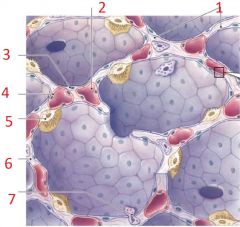
Label |
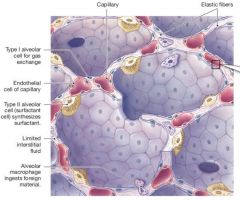
1. Elastic fibres 2. Capillary 3. Type 1 alveolar cell 4. Endothelial cell of capillary 5. Type II alveolar cell 6. (Limited) interstitial fluid 7. Alveolar macrophage |
|
|
What are the two types of alveolar cell and what role does each have? |
Type I alveolar cell - facilitates gas exchange Type II alveolar cell - synthesises surfactant |
|
|
What is the role of macrophages in the lungs? |
Ingest foreign material. |
|
|
What is special about the basement membranes between alveoli and capillaries? |
They are fused. |
|
|
What are the effects of the complex respiratory pathways? |
1. Warms air to 37 degrees 2. Raises humidity to 100% 3. Filters out foreign particles 4. Provides large surface area for gas exchange |
|
|
What is the value of the air:exchange surface area ratio? |
75 metres squared |
|
|
What is the role of goblet cells? |
Secrete mucus which traps foreign particles. |
|
|
What is the role of columnar epithelial cells? |
Have cilia which push mucus layer towards the pharynx. |
|
|
How is the mucus layer's movement facilitated? |
Watery saline layer covers cilia before mucus, allowing for easier movement. |
|
|
How is the saline layer on columnar epithelial cells formed? |
1. 'NKCC' channel brinds in chlorine ions from ECF 2. Anion channels including CFTR allow Cl- to enter the lumen. 3. Na+ enters the lumen by the paracellular pathway - drawn by the electrochemical gradient 4. NaCl movement from ECF to lumen creates an osmotic gradient which causes water to flow into the lumen. |
|
|
What is the most common mutation which causes cystic fibrosis? |
Phe 508 in the CFTR gene, coding for a Cl- anion channel. |
|
|
What is Boyle's law? |
Gas pressure of an ideal gas is inversely proportional to volume in temperature stable closed system with constant gas volume. (p1v1 = p2v2) |
|
|
What is Dalton's Law of partial pressures? |
The total pressure exerted by a mixture of non reacting gases is equal to the sum of the partial pressures of the individual gases. Ptotal = P1 + P2 + P3 .... + P'x'. |
|
|
Name and describe the four main lung capacities. |
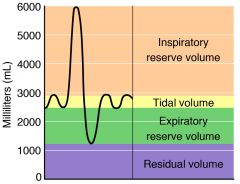
1. Residual volume - volume of air never expelled from the lungs 2. Expiratory reserve volume - amount of air which can be forcibly expired 3. Tidal volume - the volume of air inspired / expired in a normal breath 4. Inspiratory reserve volume - amount of air which can be forcibly inspired |
|
|
What are the accessory volumes? |

Inspiratory capacity : Tidal volume + Inspiratory reserve volume Functional residual capacity : Residual volume + Expiratory reserve volume + Tidal volume Vital capacity : Inspiratory reserve volume + Tidal volume + Expiratory reserve volume Total lung capacity = all 4 main capacities added together. |
|
|
How does the diaphragm change during inspiration? What does this cause? |
Diaphragm contracts and flattens - thoraic volume increases - causes air to rush in. |
|
|
How does the diaphragm change during expiration? What does this cause? |
Diaphragm relaxes - thoraic volume decreases - air rushes out |
|
|
What is flow inversely proportional to? What is the resulting meaning of this? |
Flow is inversely proportional to Change in pressure divided by resistance. This means that as resistance increases flow decreases and that air flows in response to pressure differences. This is the role of the diaphragm - to create pressure differences. |
|
|
What is the role of the pleural cavity? |
The pleural cavity is filled with fluid which keeps the lungs adhered to the chest wall. |
|
|
What happens if the pleural cavity is punctured? |
IF the sealed pleural cavity is opened to the atmosphere the air flows in and bond holding the lung to the chest wall is broke and the lung collapses. The condition is called pneumothorax = air in the thorax. |
|
|
What is pulmonary compliance? |
The ability of the lungs to expand and contract. |
|
|
What is the crucial component of lung elasticity? |
Elastin |
|
|
What occurs when elastin is lost from the airways? |
When elastin is lost from the airways compliance is reduced making expiration very difficult as the compliance of the lung gets far lower. |
|
|
What is the law of LaPlace? |

P=2T/r |
|
|
What is the significance of the law of LaPlace? |
In the lungs there are small and large alveoli - according the the law of LaPlace these two alveoli will have a pressure difference which could cause improper distribution of gases. |
|
|
How are pressure differences in the alveoli equalised? |
Secretion of surfactant - smaller alveoli have more surfactant secreted in order to balance the law of laplace. |
|
|
What is surfactant made up of? |
Surfactant is made up of a mixture of proteins and phospholipids. |
|
|
What determines efficiency of the respiratory system? |
Ventilation rate and depth of breathing. |
|
|
What is 'dead space'? |
Dead space is the given air which never reaches the gaseous exchange surface of the alveoli and sits at the top of the lungs. - 150ml of air becomes dead space. |
|
|
What is 'Eupnea'? |
Normal breathing. |
|
|
What is Hyperpnea? |
Increased respiration rate. |
|
|
What is Tachypnea? |
Rapid breathing with low depth - panting |
|
|
What is Dyspnea? |
Difficulty breathing |
|
|
What is Apnea? |
Cessation of breathing. |
|
|
How does the body compensate for under ventilated alveoli? |
Local currents divert blood flow to better ventilated alveoli. This is done through dilation / constriction of local blood vessels and bronchioles. |

